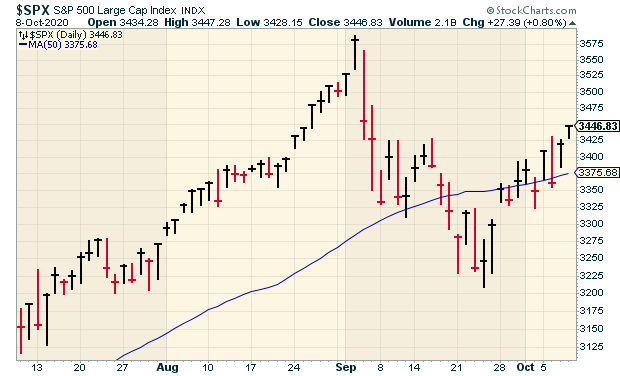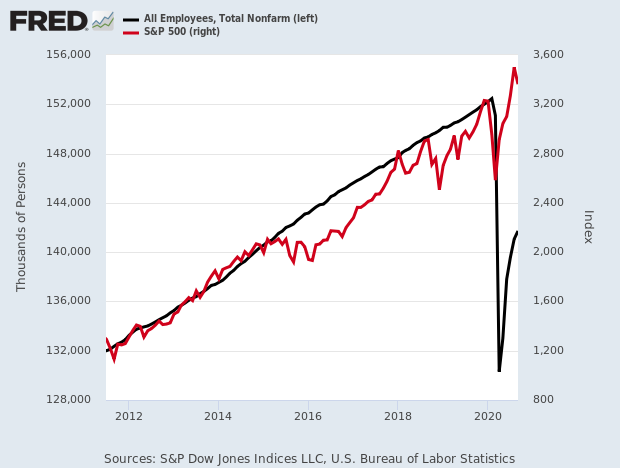CWS Market Review – October 9, 2020
“There are two times in a man’s life when he shouldn’t speculate: when he can afford to and when he can’t.” – Mark Twain
The stock market got dinged on Tuesday when President Trump said he wasn’t interested in pursuing fiscal stimulus until after the election. The markets then rebounded on Wednesday and Thursday when the president clarified that he would sign a stand-alone stimulus bill.
Just looking at the calendar, it may be too late to get any bill passed before election day. Yet despite the impasse, the stock market has been in a cheery mood of late. The S&P 500 has closed higher eight times in the last eleven sessions. On Thursday, the index finished the day at a five-week high.

Will it last? Frankly, I’m skeptical. The V-shaped recovery is looking wobbly, and this week’s Fed minutes agreed. We also have the Q3 earnings season coming soon, plus there’s the uncertainty of the upcoming election. In this week’s issue, I’ll try to sort it all out for you.
I’ll also cover the recent earnings report from RPM International, and it was a good one. RPM topped Wall Street’s consensus by 25 cents per share and raised its dividend for the 47th year in a row. Not bad.
Later on, I’ll unveil our calendar for this earnings season so you’ll know exactly what to expect. But first, let’s look at the recent jobs report and what it says about the economy.
The U.S. Economy Has Made Back Half the Jobs It Lost
Last Friday, the government released the jobs numbers for September. The U.S. economy created 661,000 net new jobs last month. That was below Wall Street’s estimates of 800,000. Normally, a gain of more than 600,000 a month is an astounding number. However, in the age of the Covid-19, it’s actually the slowest gain of the last five months.
What’s happening is that the tremendous bounce back from the economic lockdown is starting to wane. Actually, there have been hints of this for some time, but now we have solid data.
The unemployment rate fell to 7.9%. Wall Street’s estimate was for 8.2%. Even though the jobless rate has been nearly cut in half since April, it’s still higher than the peak rate hit during the recession of the early 1990s.
In simple terms, the U.S. economy lost 22 million jobs in two months. In the five months since then, the economy has recovered 11 million jobs. Yes, it’s an impressive recovery, but it’s only about halfway back to the status quo ante.
Here’s a chart of nonfarm payrolls (black) along with the S&P 500 (red). Both lines dipped, but stocks recovered more robustly than did jobs.

The bottom line is that the US economy is still adding jobs but at a slower rate than it had been before. The private sector added 877,000 net new jobs last month. The labor-force participation rate fell to 61.4% for September. Average hourly earnings rose by 0.1%.
We got more confirmation of the slowing jobs growth with the latest jobless-claims report. On Thursday, it was reported that 840,000 Americans filed for first-time claims. That was a little higher than Wall Street’s estimate of 825,000. Although it’s another six-month low, this was the sixth weekly report in a row that fell in the range of 800,000 to 900,000.
In plain terms, the boost from the re-opening is gone, and it looks like the economy is stabilizing within a new, and lower, range. Of course, there are many more variables to consider, and it adds extra attention to the stimulus debate in Washington. This view was confirmed this week by the release of the minutes to the most recent Federal Reserve meeting.
The minutes said, “Many participants noted that their economic outlook assumed additional fiscal support and that if future fiscal support was significantly smaller or arrived significantly later than they expected, the pace of the recovery could be slower than anticipated.” That’s unusually bold language for a central bank, but I see their point.
Again, I urge investors to be cautious. Make sure you’re well diversified and have plenty of dividend-payers in your portfolio. I expect more good earnings news from our stocks once earnings season heats up, but you never know how the market will react. Now let’s look at our Buy List earnings report from this week.
RPM Beats Earnings and Raises Dividend
On Wednesday, RPM International (RPM) reported very good earnings for its fiscal Q1. This was for the quarter that ended on August 31. RPM is one of those fairly dull companies that I like. RPM consistently churns out solid numbers.
For the quarter, sales rose 9.1% to $1.61 billion, and net income increased by 70% to $180.6 million. RPM made $1.44 per share, which was a 51% jump over last year’s Q1. That result beat Wall Street’s estimate by 25 cents per share.
CEO Frank C. Sullivan said:
During our fiscal 2021 first quarter, select segments of the global economy began to gain momentum as stay-at-home orders were relaxed, which freed pent-up demand from last year’s fourth quarter. This helped drive our record top-line results, which grew 9.1% over the prior-year period. This was in sharp contrast to the Covid-19-related sales decline we reported for the fiscal 2020 fourth quarter. Our two largest segments, the Construction Products Group and the Consumer Group, posted positive growth in the first quarter, while the other two segments declined.
Let’s look at the breakdown by RPM’s four business groups. The Construction Products Group saw Q1 sales rise by 2.2% to $547.7 million. Performance Coatings had a sales decrease of 12.6% to $259.8 million. The Consumer Group was the star. It had a sales increase of 33.8% to $641.2 million. Lastly, Specialty Products Group had a sales decrease of 1.3% to $158.0 million
The strong quarterly results helped RPM’s balance sheet. Cash generated from operations more than doubled to $318.1 million. During the quarter, RPM reduced its total debt by $200 million. That’s good to see.
For fiscal Q2, RPM expects “sales growth in the low- to mid-single digits with strong leverage to the bottom line for more than 20% adjusted EBIT growth.”
RPM didn’t provide full-year earnings guidance, but the company believes Construction Products and Performance Coatings could experience sales declines for the next two quarters and then turn positive in the fourth quarter. Specialty Products is likely to see flat sales, while the Consumer Group should experience strong sales growth this year.
On Thursday, RPM said that it’s raising its quarterly dividend from 36 cents to 38 cents per share. That’s an increase of 5.6%. Moreover, it’s RPM’s 47th annual dividend increase in a row. Only 41 other companies can boast of a streak that long. The dividend will be paid on October 30 to stockholders of record as of October 19. Going by Thursday’s close, RPM now yields 1.7%.
After the earnings report, the stock gapped up some. On Thursday, it briefly went above $90 per share before pulling back. We now have a 13% gain this year with RPM. The stock remains a good buy up to $90 per share.

Q3 Earnings Calendar
Over the next few weeks, 21 of our 25 Buy List stocks will report their earnings. Here’s a list of companies along with the earnings dates.
Also, I don’t have all the earnings dates just yet. As I like to say, some companies are better at shareholder communication than others.
 Eddy Elfenbein is a Washington, DC-based speaker, portfolio manager and editor of the blog Crossing Wall Street. His
Eddy Elfenbein is a Washington, DC-based speaker, portfolio manager and editor of the blog Crossing Wall Street. His